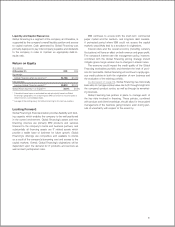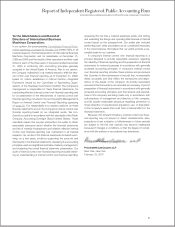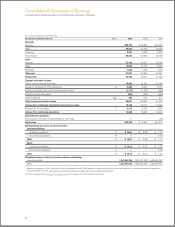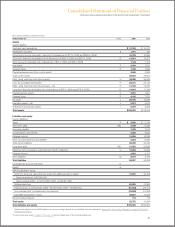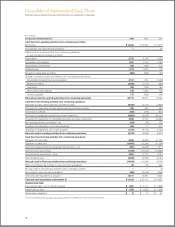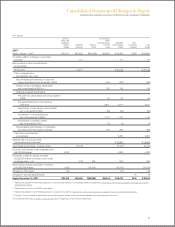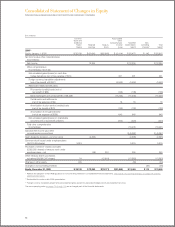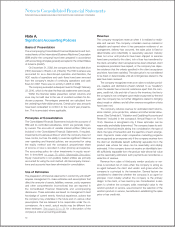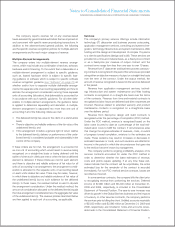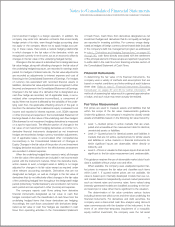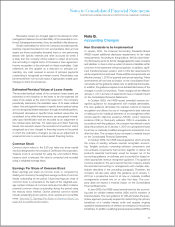IBM 2009 Annual Report Download - page 73
Download and view the complete annual report
Please find page 73 of the 2009 IBM annual report below. You can navigate through the pages in the report by either clicking on the pages listed below, or by using the keyword search tool below to find specific information within the annual report.
Notes to Consolidated Financial Statements
INTERNATIONAL BUSINESS MACHINES CORPORATION AND SUBSIDIARY COMPANIES
The company reports revenue net of any revenue-based
taxes assessed by governmental authorities that are imposed on
and concurrent with specific revenue-producing transactions. In
addition to the aforementioned general policies, the following
are the specific revenue recognition policies for multiple-element
arrangements and for each major category of revenue.
Multiple-Element Arrangements
The company enters into multiple-element revenue arrange-
ments, which may include any combination of services, software,
hardware and/or financing. To the extent that a deliverable in a
multiple-element arrangement is subject to specific guidance,
such as, leased hardware which is subject to specific leas-
ing guidance or software which is subject to specific software
revenue recognition guidance (see “Software” on page 72) on
whether and/or how to separate multiple deliverable arrange-
ments into separate units of accounting (separability) and how to
allocate the arrangement consideration among those separate
units of accounting (allocation), that deliverable is accounted for
in accordance with such specific guidance. For all other deliv-
erables in multiple-element arrangements, the guidance below
is applied to determine separability and allocation. A multiple-
element arrangement is separated into more than one unit of
accounting if all of the following criteria are met:
• The delivered item(s) has value to the client on a stand-alone
basis;
• There is objective and reliable evidence of the fair value of the
undelivered item(s); and
• If the arrangement includes a general right of return relative
to the delivered item(s), delivery or performance of the unde-
livered item(s) is considered probable and substantially in the
control of the company.
If these criteria are not met, the arrangement is accounted for
as one unit of accounting which would result in revenue being
recognized on a straight-line basis or being deferred until the
earlier of when such criteria are met or when the last undelivered
element is delivered. If these criteria are met for each element
and there is objective and reliable evidence of fair value for all
units of accounting in an arrangement, the arrangement consid-
eration is allocated to the separate units of accounting based
on each unit’s relative fair value. There may be cases, however,
in which there is objective and reliable evidence of fair value of
the undelivered item(s) but no such evidence for the delivered
item(s). In those cases, the residual method is used to allocate
the arrangement consideration. Under the residual method, the
amount of consideration allocated to the delivered item(s) equals
the total arrangement consideration less the aggregate fair value
of the undelivered item(s). The revenue policies described below
are then applied to each unit of accounting, as applicable.
Services
The company’s primary services offerings include information
technology (IT) datacenter and business process outsourcing,
application management services, consulting and systems inte-
gration, technology infrastructure and system maintenance, Web
hosting and the design and development of complex IT systems
to a client’s specifications (design and build). These services are
provided on a time-and-material basis, as a fixed-price contract
or as a fixed-price per measure of output contract and the
contract terms range from less than one year to over 10 years.
Revenue from IT datacenter and business process outsourc-
ing contracts is recognized in the period the services are provided
using either an objective measure of output or a straight-line basis
over the term of the contract. Under the output method, the
amount of revenue recognized is based on the services delivered
in the period.
Revenue from application management services, technol-
ogy infra structure and system maintenance and Web hosting
contracts is recognized on a straight-line basis over the terms
of the contracts. Revenue from time-and-material contracts is
recognized as labor hours are delivered and direct expenses are
incurred. Revenue related to extended warranty and product
maintenance contracts is recognized on a straight-line basis
over the delivery period.
Revenue from fixed-price design and build contracts is
recognized under the percentage-of-completion (POC) method.
Under the POC method, revenue is recognized based on the
labor costs incurred to date as a percentage of the total esti-
mated labor costs to fulfill the contract. If circumstances arise
that change the original estimates of revenues, costs, or extent
of progress toward completion, revisions to the estimates are
made. These revisions may result in increases or decreases in
estimated revenues or costs, and such revisions are reflected in
income in the period in which the circumstances that gave rise
to the revision become known by management.
The company performs ongoing profitability analyses of its
services contracts accounted for under the POC method in
order to determine whether the latest estimates of revenue,
costs and profits require updating. If at any time these esti-
mates indicate that the contract will be unprofitable, the entire
estimated loss for the remainder of the contract is recorded
immediately. For non-POC method service contracts, losses are
recorded as incurred.
In some services contracts, the company bills the client prior
to recognizing revenue from performing the services. Deferred
income of $7,066 million and $6,403 million at December 31,
2009 and 2008, respectively, is included in the Consolidated
Statement of Financial Position. The year-to-year increase was
driven by growth in the Global Services business and the impacts
of currency. In other services contracts, the company performs
the services prior to billing the client. Unbilled accounts receivable
of $2,020 million and $2,090 million at December 31, 2009 and
2008, respectively, are included in notes and accounts receiv-
able-trade in the Consolidated Statement of Financial Position.
71


